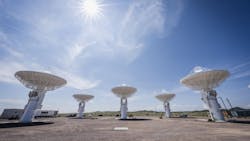Northrop Grumman to build second long-range radar system to track satellites in geosynchronous orbits
PETERSON SPACE FORCE BASE, Colo. – U.S. Space Force surveillance experts are asking Northrop Grumman Corp. to design and build a second long-range radar system to detect, identify, and track satellites and other spacecraft in high-altitude geosynchronous orbits around Earth.
Officials of the Space Force Space Systems Center Directorate of Contracting at Peterson Space Force Base, Colo., announced a $200.3 million contract to Northrop Grumman in August for the second Deep Space Advanced Radar Capability (DARC) site in Wales in the Western United Kingdom.
This contract is for DARC Site 2. Northrop Grumman won a contract to build the first DARC site in 2021 in Western Australia. It is to be completed next year and begin operations in 2026.
DARC is to be one of the world’s most advanced radars for tracking objects in deep space. It is to monitor objects in geosynchronous orbit 22,000 miles above the equator continuously in all weather conditions.
DARC will locate and track satellites in and on the way to geosynchronous orbit, and will replace or augment existing tools that lack the sensitivity and capacity to track them precisely. These systems can be hindered by sunlight and weather.
DARC, meanwhile, will provide an all-weather continuous monitoring of geosynchronous orbits. If a collision threatens a satellite, DARC alerts the operator in enough time to maneuver the satellite away from the oncoming debris. DARC also will identify enemy attempts to disrupt or deny civil and military space services.
A DARC demonstrator, which uses a sparse array of dish antennas to track objects in space, was tested at White Sands Missile Range, N.M., in late 2021. The test involved a sub-scale version of the DARC system to demonstrate its ability to broadcast a signal at specific test objects in space.
The future operational DARC system will consist of three high-powered transmit/receive sites, spaced at mid-latitudes around the world. The future DARC network will be operated by the United States, Australia and the United Kingdom.
On this contract Northrop Grumman will do the work in Colorado Springs, Colo., and should be finished by February 2030. For more information contact Northrop Grumman online at www.northropgrumman.com.
About the Author
John Keller
Editor-in-Chief
John Keller is the Editor-in-Chief, Military & Aerospace Electronics Magazine--provides extensive coverage and analysis of enabling electronics and optoelectronic technologies in military, space and commercial aviation applications. John has been a member of the Military & Aerospace Electronics staff since 1989 and chief editor since 1995.
